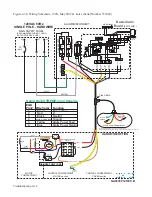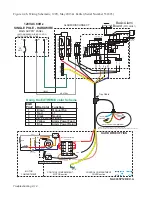
Troubleshooting 2–10
Possible Causes
Troubleshooting Steps
Normal Operation
The pump may be grinding material. Wait a few minutes. If the pump does not
quiet down, remove the pump and clean the basin.
Low Voltage
Check the voltage level. The voltage is listed on the pump nameplate.
Note:
Voltage must be within 10 percent of nameplate voltage (240V: 216V to 264V;
120V: 108V to 132V). 208V requires a buck boost transformer.
Blocked Discharge
Check the amperage. If amperage is high (8 amps or higher on 240V; 16 amps
or higher on 120V), turn off the pump and check the discharge line for a block-
age. Confirm that the pump has not been damaged by disconnecting the dis-
charge piping and recycling the fluid in the tank. Turn on the pump power and
check the amperage. If amperage remains high, replace the pump and return
the failed pump to shop for possible motor repair. If amperage returns to normal,
clear discharge and recheck.
Damaged Stator
Check the stator for holes or tears.
Chapter 5 – Pump End
describes the pump
stator inspection procedure.
Worn Motor Bearing
Remove the pump stator and hand-rotate the shaft. If the shaft turns roughly,
replace the pump. Return the failed pump to the shop and replace the motor
bearings as described in
Chapter 10 – Motor Cavity.
Noisy Pump
Table 2–11
Possible Causes
Troubleshooting Steps
High flow
The incoming flow is greater than the pump can handle. Infiltration, a sump
pump, a hot tub or any other appliance that produces excessive water flow can
cause a high flow alarm.
Plugged vent or Equal-
izer tube
Check the vent and the Equalizer tube. A plugged or partially plugged vent or
Equalizer tube will cause the alarm to activate frequently. Replace the Equalizer
tube if kinked or damaged.
Level sensor leak
Remove the pump from the tank. Inspect the level sensors for cracks and debris;
use level sensor test to check for leaks.
Line blockage or worn
stator
Check the amperage. If amperage is high, look for a line blockage. If amperage
is low, inspect the stator for excessive wear.
Underground wire dam-
age
Check the tray cable wiring for cuts, breaks and shorts. Use a megohmmeter to
check for shorts between each pair of leads. Replace the tray cable if a short is
found.
Alarm Activates Frequently
Table 2–10
Summary of Contents for Extreme Series
Page 1: ...Service Manual E One Extreme Grinder Pumps 240V 60 Hz Hardwired Controls...
Page 2: ......
Page 32: ...Pump End 5 8 Figure 5 9a D Series Pump Exploded View...
Page 33: ...Pump End 5 9 Figure 5 9b W Series Pump Exploded View...
Page 34: ...Pump End 5 10 Figure 5 9c Gatorgrinder GH Series Pump Exploded View...
Page 35: ...Pump End 5 11 Figure 5 9d IH091 Pump Exploded View...
Page 36: ...Pump End 5 12...
Page 58: ...Level Sensor 8 10 Figure 8 35 Level Sensor Assembly Exploded View all hardwired pumps...
Page 70: ...Mechanical Seal Assembly 11 2...
Page 75: ......
















































